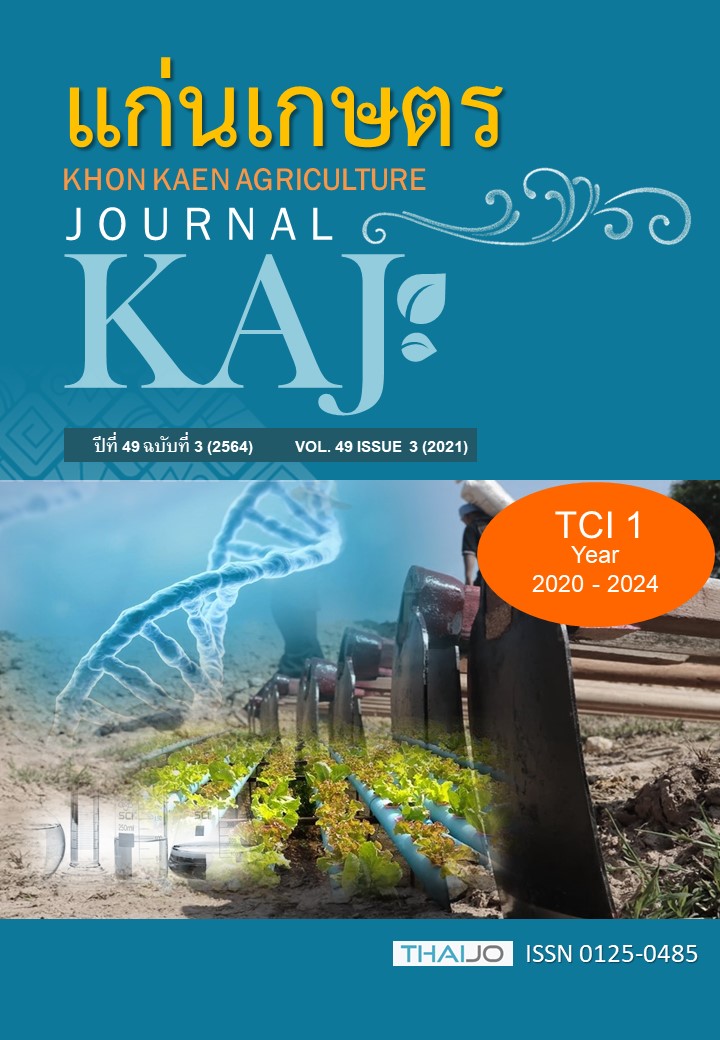การผลิตพลาสติกชีวภาพจากกล้วยโดยแบคทีเรียที่คัดแยกได้จากดิน
Main Article Content
บทคัดย่อ
งานวิจัยนี้มีวัตถุประสงค์เพื่อศึกษาการผลิตพลาสติกชีวภาพชนิดพอลิไฮดรอกซีอัลคาโนเอต (Polyhydroxyalkanoates; PHAs) ด้วยแบคทีเรียที่คัดแยกได้จากตัวอย่างดินจังหวัดนครนายกและจังหวัดฉะเชิงเทรา โดยใช้กล้วยสุกงอม 3 ชนิด ได้แก่ กล้วยไข่ กล้วยหอม และกล้วยน้ำว้า เป็นแหล่งคาร์บอนสำหรับการเจริญของจุลินทรีย์ จากตัวอย่างดินสามารถคัดแยกและจำแนกแบคทีเรียที่ผลิต PHAs ได้ทั้งหมด 16 สายพันธุ์ โดยแบคทีเรียที่คัดแยกได้รหัส N22-3 มีปริมาณร้อยละของการสะสม PHAs สูงที่สุดคือ 30.10±0.25% ในอาหารที่มีการเติมน้ำกล้วยไข่ จากการตรวจสอบลักษณะทางสัณฐานวิทยาพบว่าแบคทีเรียซึ่งคัดแยกได้รหัส N22-3 เป็นแบคทีเรียแกรมลบ และจำแนกสายพันธุ์โดยวิธี 16S rRNA พบว่ามีความเหมือน 99.85% กับแบคทีเรียสายพันธุ์ Klebsiella pneumoniae เมื่อตรวจสอบโครงสร้างของแผ่นฟิล์มที่ผลิตได้พบว่ามีโครงสร้างคล้ายกับสารพอลิเมอร์ชีวภาพมาตรฐานชนิดพอลิไฮดรอกซีบิวไทเรต (polyhydroxybutyrate; PHB)
Article Details

อนุญาตภายใต้เงื่อนไข Creative Commons Attribution-NonCommercial-NoDerivatives 4.0 International License.
เอกสารอ้างอิง
Abou-Zeid, D. M. 2001. Anaerobic biodegradation of natural and synthetic polyesters. Ph.D. Dissertations in Science, Technical University Carolo-Wilhelmina at Brunswick, Germany.
Bengtsson, S., A. Werker, M. Christensson, and T. Welander. 2008. Production of polyhydroxy lalkanoates by activated sludge treating a paper mill wastewater. Bioresource Technology. 99: 509-511.
Bernard, M. 2014. Industrial potential of polyhydroxyalkanoate bioplastic: a brief review. University of Saskatchewan Undergraduate Research Journal. 1: 1-14.
Burdon, K. L. 1946. Fatty material in bacteria and fungi revealed by staining dried, fixed slide preparations. Journal of Bacteriology. 52: 665-678.
Cavalheiro, J. M. B. T., M. C. M. D. Almeida, C. Grandfils, and M. M. R. Fonseca. 2009. Poly(3-hydroxybutyrate) production by Cupriavidus necator using waste glycerol. Process Biochemistry. 44: 509-515.
Chen, G. Q. 2009. A microbial polyhydroxyl alkanoates (PHA) based bio-and materials industry. Chemical Society Reviews. 38: 2434-2466.
Dubois, M., K. A. Gilles, J. K. Hamilton, P. A. Rebers, and F. Smith. 1956. Colorimetric method for determination of sugars and related substances. Analytical Chemistry. 28: 350-356.
El-Sayed, A. A., H. M. Abdelhady, A. M. Hafez, and T. A. Khodair. 2009. Batch production of polyhydroxybutyrate (PHB) by Ralstonia eutropha and Alcaligenes latus using bioreactor different culture strategies. Journal of Applied Sciences Research. 5: 556-564.
Getachew, A., and F. Woldesenbet. 2016. Production of biodegradable plastic by polyhydroxybutyrate (PHB) accumulating bacteria using low cost agricultural waste material. BMC Research Notes. 9: 509.
Grothe, E., M. Moo-Young, and Y. Chisti. 1999. Fermentation optimization for the production of poly (ß-hydroxybutyric acid) microbial thermoplastic. Enzyme and Microbial Technology. 25:132-141.
Gouda, M. K., A. E. Swellam, and S. H. Omar. 2001. Production of PHB by Bacillus megaterium strain using sugarcane molasses and corn steep liquor as sole carbon and nitrogen sources. Microbiological Research. 156: 201-207.
Mezzolla, V., O. F. D’Urso, and P. Poltronieri. 2017. Optimization of polyhydroxyalkanoate production by recombinant E. coli supplemented with different plant by-products. BioTechnology: An Indian Journal. 13: 138-155.
Janes B., J. Hollar, and D. Dennis. 1990. Molacular characterization of the poly-β-hydoxybutyrate biosynthetic pathway of Alcaligenes eutrophus H16. In: Novel biodegradable microbial polymer. (Eds: Dawes, E.A.). The Netherlands. Kluwer Academic Publisher. Dordrecht.
Kunasundari, B., and K. Sudesh. 2011. Isolation and recovery of microbial polyhydroxyalkanoates. eXPRESS Polymer Letters. 5: 620-634.
Nandini, P., C. Amruta, P. Bhavesh, R. Pragya, V. Priti, and P. Mital. 2011. Screening of PHB (polyhydroxyalkanoates) producing bacteria from diverse sources. Microbial Biotechnology. 36: 216-274.
Phathipchotikun, R., P. Piwpan, A. Jaturapiree, and P. Jaturapiree. 2014. Polyhydroxybutyrate (PHB) production by Alcaligenes eutrophus NCIMB 11599 from low-cost substrate as carbon source. KKU Research Journal. 19(Supplement Issue): 53-59.
Santhanam, A., and S. Sasidharan. 2010. Microbial production of polyhydroxyalkanotes (PHA) from Alcaligenes spp. and Pseudomonas oleovorans using different carbon sources. African Journal of Biotechnology. 9: 3144-3150.
Singhaboot, P., and P. Kaewkannetra. 2015. A higher in value biopolymer product of polyhydroxyalkanoates (PHAs) synthesized by Alcaligenes latus in batch/repeated batch fermentation processes of sugar cane juice. Annals of Microbiology. 65: 2081-2089.
Suwannasing, W., S. Moonamart, and P. Kaewkannetra. 2011. Yields of polyhydroxyalkanoates (PHAs) during batch fermentation of sugar cane juice by Alcaligenes latus and Alcaligenes eutrophus. Life Science Journal. 5: 960-966
Suwannasing, W., T. Imai, and P. Kaewkannetra. 2015. Cost-effective defined medium for the production of polyhydroxyalkanoates using agricultural raw materials. Bioresource Technology. 194: 67-74.
Tanamool, V., T. Imai, P. Danvirutai, and P. Kaewkannetra. 2013. Biopolymer generation from sweet sorghum juice: screening, isolation, identification, and fermentative polyhydroxyalkanoate production by Bacillus aryabhattai. Turkish Journal of Biology. 37: 259-264.
Tufail, S., S. Munir, and N. Jamil. 2017. Variation analysis of bacterial polyhydroxyalkanoates production using saturated and unsaturated hydrocarbons. Brazilian Journal of Microbiology. 48: 629-636.
Vega, E. Z., B. A. Glatz, and E. G. Hammond. 1988. Optimization of banana juice fermentation for the production of microbial oil. Applied and Environmental Microbiology. 54: 748-752.


